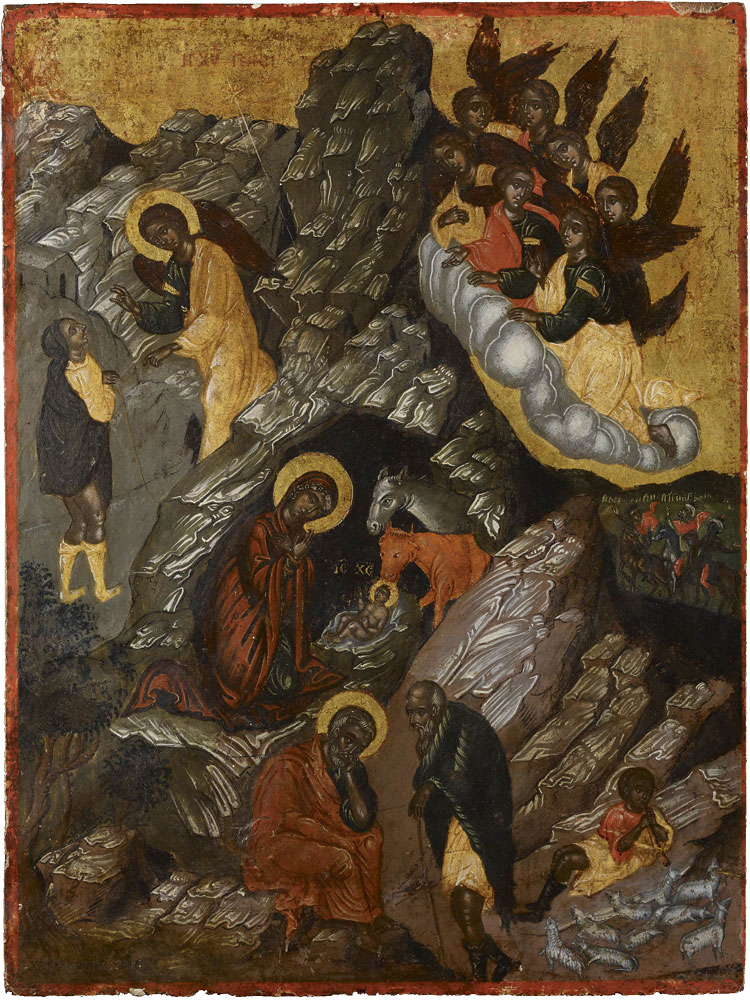The icon is painted in egg tempera with gold leaf on wood primed with gesso over linen. The scene is identified by a red inscription: HXV ΓΕΝΝ. A rocky background occupies most of the composition with the cave placed in the centre of it. The Virgin is depicted kneeling in front of the cave to the left and turned towards the right, where the manger is placed. Inside the manger Christ is lying naked on a white sheet and is looking upwards towards his mother while two animals (an ox and an ass) are standing above the manger and bringing their heads close to Christ. In the middle of the foreground lower than the cave Joseph is seated and converses with an old shepherd standing in front of him. Behind the old shepherd, a young one is seated and plays the flute while tending his numerous sheep. Above the cave to the left an angel is conversing with a young shepherd, who is standing opposite him. A group of seven flying angels appear from a white cloud to the right of the cave on the golden background. The three Magi on horses are approaching from the right side of the composition and are heading to the cave. In the bottom left corner is the Greek inscription: XEIP KωNCTANTINOY TZANE (‘the hand of Konstantinos Tzanes’).
Most of the iconographic features in this composition of the Nativity are the standard ones in the representation of the theme. What is uncommon is the absence of the bathing of Christ by the midwife, usually placed on the foreground. The feature of the kneeling Virgin in front of the manger instead of the reclining one is a western element that makes its appearance in Cretan icons of the Nativity from the second half of the 15th century. See, for example, a composite icon in the Musée d’art et d’histoire in Geneva attributed to Nikolaos Tzafouris (Frigerio-Zeniou and Lazović 2006), a triptych in the Hermitage painted by Nikolaos Tzafouris (Piatnitsky et al 2000), and an icon in a private collection in Athens (Chatzidakis 1983), all dating to the second half of the 15th century. The feature of the kneeling Virgin was further established by the Cretan painter Theophanes in his icons and fresco decorations on Mount Athos, such as a fresco (Chatzidakis 1986) and an icon in the Stavronikita Monastery dated 1545/46 (Chatzidakis and Drakopoulou 1997).
The BM icon bears the signature of Konstantinos Tzanes Bounialis who was of Cretan origin but spent most of his life in Venice, where he is documented from the year 1655 till his death. Konstantinos, born in Rethymnon, Crete, must have left his native town after its capture by the Ottoman Turks in 1645. He was brother of the famous Cretan painter Emmanuel Tzanes and of the poet Marinos Tzanes Bounialis (Chatzidakis and Drakopoulou 1997; Constantoudaki-Kitromilides 2003). Konstantinos died in Venice between 1682 and 1685.
Literature: N. Chatzidakis, Icons of the Cretan School (15th–16th century) (exh. cat., The Benaki Museum), Athens, 1983, no. 24; M. Chatzidakis, The Cretan Painter Theophanes: the Final Period of his Art in the Frescoes in Stavronikita Monastery, Mount Athos, 1986, fig. 83; Christie’s, Icons, South Kensington, Wednesday 4 December 1991, lot 36, 7, ill. on 6; M. Chatzidakis and E. Drakopoulou, Έλληνες ζωγράφοι μετά την Άλωση (1450–1830), Athens, 1997, 424–6, fig. 280; Υ. Piatnitsky, O. Baddeley, E. Brunner and M. Mundell Mango (eds), Sinai, Byzantium, Russia. Orthodox Art from the Sixth to the Twentieth Century (exh. cat., Courtauld Gallery) London, 2000, no. B155; M. Constantoudaki-Kitromilides, ‘Από το Ρέθυμνο στη Βενετία: ο ζωγράφος Κωνσταντίνος Τζάνε Μπουνιαλής και η εξέλιξη της τέχνης του’, in C. Maltezou and A. Papadaki (eds), Rethymno veneziano. Atti del Simposio, Rethymno, 1–2 novembre 2002, Venice, 2003, 415–34; S. Frigerio-Zeniou and M. Lazović, Icônes de la collection du Musée d’art et d’histoire Genève, Geneva, 2006, no. 3; R. Cormack, Icons, London, 2014 (2nd ed.), 140, no. 112.
Maria Vassilaki
